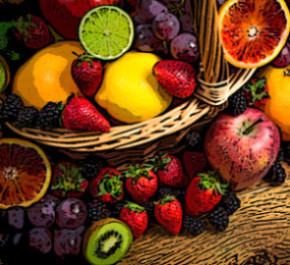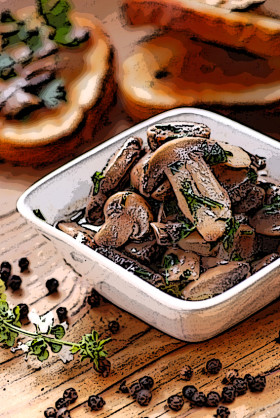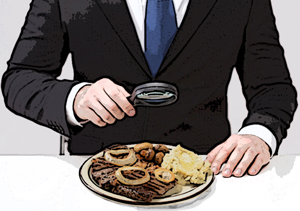In Other Words – Euphemisms In Wine Journalism.
Chapter Six, Part One.
 Once you’ve learned to decipher wine’s elusive qualities you may also need some tips on how to express your observations. In addition to the correlation between the flavors found in wine and the flavors found in your average fruit basket, you’ll want to describe wine’s appearance, texture, weight, oak, and umm … what’s that other one? Oh yeah, arsenic.
Once you’ve learned to decipher wine’s elusive qualities you may also need some tips on how to express your observations. In addition to the correlation between the flavors found in wine and the flavors found in your average fruit basket, you’ll want to describe wine’s appearance, texture, weight, oak, and umm … what’s that other one? Oh yeah, arsenic.
We turn to wine critics for help with these thorny descriptors because they are so much more than mere wine aficionados. That’s right, wine critics are also self-aggrandizing blowhards. No wait! That’s not it! I meant to say they are also writers.
Read MoreThe Umami Tsunami.
Chapter Eight, Part Three.
One + One = Three (The Synergy Of Umami).
 The subtle, savory fifth taste known as umami was first identified by Japanese scientist Kikunae Ikeda in 1907. In researching umami he discovered that it was linked with the amino acid glutamate and his investigations led to the development of monosodium glutamate (MSG) as a flavor enhancer. I could feed you lots of material about the development of umami-rich MSG but you would just be hungry for more in an hour.
The subtle, savory fifth taste known as umami was first identified by Japanese scientist Kikunae Ikeda in 1907. In researching umami he discovered that it was linked with the amino acid glutamate and his investigations led to the development of monosodium glutamate (MSG) as a flavor enhancer. I could feed you lots of material about the development of umami-rich MSG but you would just be hungry for more in an hour.
The umami tsunami began in earnest six years after Ikeda’s discovery when his follower Shintaro Kodama learned that glutamate, when combined with nucleotides, creates a dramatic flavor enhancing synergy. For example, when meat (high in the nucleotide inosinate) is combined with glutamate-rich foods like tomatoes or cheese, a significant umami boost is created. To understand the power of this synergy, think of the flattering outcome when you add cheese to a hamburger or braciola to tomato sauce (or as we say in New Jersey, you put the bruh-johl in the gravy).
Read MoreIn Search Of Umami.
Chapter Eight, Parts One & Two.
Where Have You Been All My Life?
 Sweet, sour, salt, bitter … sweet, sour, salt, bitter. I repeated those words at so many events for so many years that the phrase was like my own personal mantra, rooted in my psyche by daily visits to the Deli Lama. Just imagine my concern when I learned of umami – the existence of a fifth taste was surely going to throw off my mantra rhythm. Sweet, sour, salt, bitter … UMAMI? It has a good beet but you just can’t trance to it.
Sweet, sour, salt, bitter … sweet, sour, salt, bitter. I repeated those words at so many events for so many years that the phrase was like my own personal mantra, rooted in my psyche by daily visits to the Deli Lama. Just imagine my concern when I learned of umami – the existence of a fifth taste was surely going to throw off my mantra rhythm. Sweet, sour, salt, bitter … UMAMI? It has a good beet but you just can’t trance to it.
Not only did this secretive fifth taste exist, it existed right under my nose – where my mouth is conveniently located. I knew if I was ever going to get my mantra groove back I needed to embrace the mystical taste I’d overlooked for so long. I gathered articles and books on the subject and soon learned that describing the taste of umami is like describing the flavor of wine, it’s just so many words on a page. Umami, like wine, must be experienced to be understood.
Read MoreThe Wine Tasting Stream of Consciousness.
Chapter Four. Part Three.
 It’s wine tasting season in New York once again. A season-ending injury kept me out of the fall tasting line-up and at the first spring event I started slurring my speech, dropped several wine glasses and fell down twice. I became disoriented, dizzy and incoherent so I did the only sensible thing.
It’s wine tasting season in New York once again. A season-ending injury kept me out of the fall tasting line-up and at the first spring event I started slurring my speech, dropped several wine glasses and fell down twice. I became disoriented, dizzy and incoherent so I did the only sensible thing.
I drove myself straight home.
Years ago, when I first started attending wine tastings, I developed an olfactory/gustatory associative process to try to pinpoint the flavors and aromas that seemed so familiar yet so elusive. The first time I recognized the taste of vanilla in a red wine is a good illustration of how this free flowing stream of consciousness unfolds.
Read MoreWho Put The Bop In The Bop Shoo-Bop Shoo-Bop?
or “Where Do All Those Wonderful Flavors Come From!”
Chapter Ten. Part One.
 Regular followers of WineSnark have learned how to discern and describe the varied vagaries of vino but have you ever wondered where these peculiarities come from? Why does Syrah from the Rhone Valley taste different from Shiraz produced in Australia? (Syrah and Shiraz are the same grape variety but our spell buds perceive them differently). Where does the “butter” flavor come from in some Chardonnays? How come Cabernet Sauvignon can taste like blackberries or like vanilla? What makes Pinot Noir taste different from Pinot Gris?
Regular followers of WineSnark have learned how to discern and describe the varied vagaries of vino but have you ever wondered where these peculiarities come from? Why does Syrah from the Rhone Valley taste different from Shiraz produced in Australia? (Syrah and Shiraz are the same grape variety but our spell buds perceive them differently). Where does the “butter” flavor come from in some Chardonnays? How come Cabernet Sauvignon can taste like blackberries or like vanilla? What makes Pinot Noir taste different from Pinot Gris?
The answer to these questions can be found in the science of winemaking. Now don’t roll your eyes and reach for the mouse. I realize the onus of this site is flavor and not geography, meteorology, botany or chemistry, but this stuff has everything to do with the quality of wine and it’s about time WineSnark examine the scientific foundation of these unique flavors. I promise to keep it simple and I won’t even use a periodic table, unless I need someplace to set my wine glass.
Read More



















